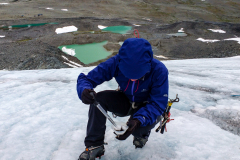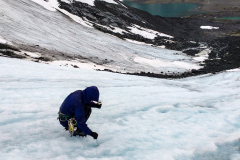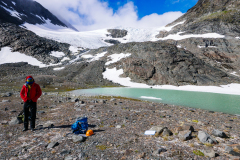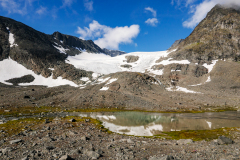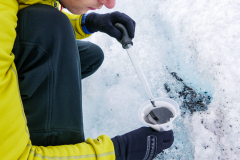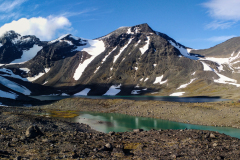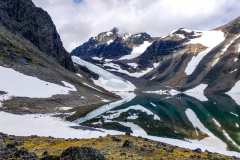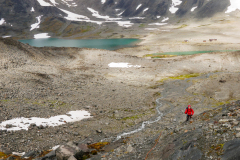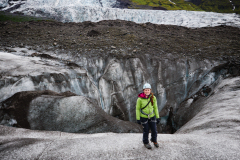CE12 – A Nuclear Legacy Buried in Ice
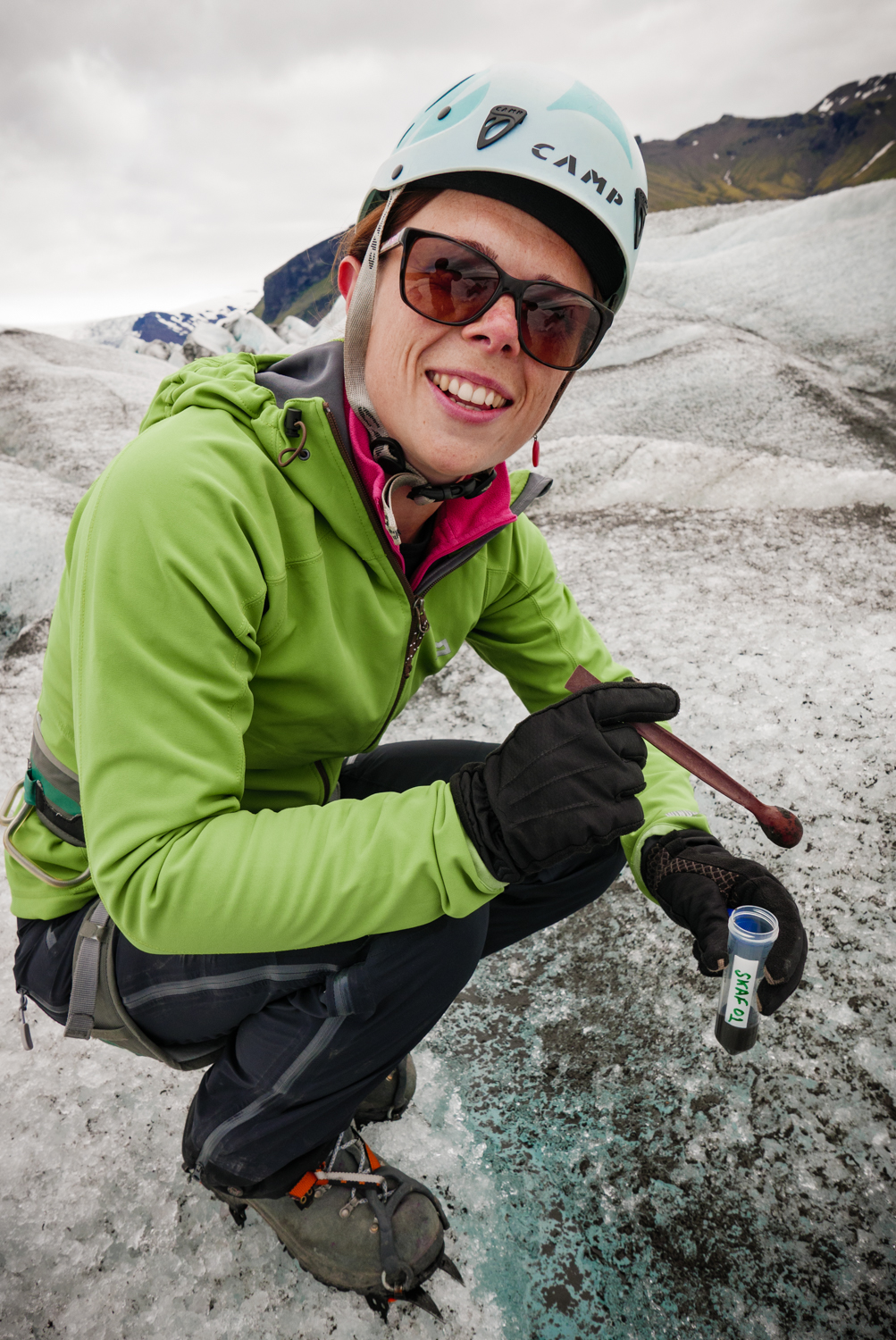
Clason sampling cryoconite in Iceland. Credit: Caroline Clason
Earlier this year, scientists reported that radioactive fallout from nuclear accidents and weapons testing is present in ice sediments on the surface of glaciers in the Arctic, Iceland, the Alps, the Caucasus, British Columbia and Antarctica.
The presence of this radioactivity poses a potential problem to humans and animals living near glaciers. As the ice melts as a result of climate change, the radioactive fallout could wind up in rivers and streams, and potentially make its way up the food chain.
In the latest episode of Third Pod from the Sun, University of Plymouth scientist Caroline Clason details how she and her team discovered the radioactive fallout on the glaciers and what questions they are still investigating, including the potential effect of the radionuclides on ecosystems.
This episode was produced by Nanci Bompey and Lauren Lipuma and mixed by Robyn Murray and Jon Schriner.
Transcript:
Shane Hanlon: Hi Nanci.
Nanci Bompey: Hi Shane. So, hi. Like, this is the most painful part of the day, right here?
Shane Hanlon: Oh goodness. Oh no, no. All right, let’s bring it up. I have a question for you.
Shane Hanlon: Let’s pretend that you have to go into a fallout shelter for … thinking as far as … Yeah, we’re just diving into it. There’s no pretense anymore. What is something that you would want to take with you to stay entertained for… God, weeks, months, years?
Lauren Lipuma: I can answer this for Nancy.
Shane Hanlon: And Lauren’s here, too.
Nanci Bompey: Really, you could?
Lauren Lipuma: Books.
Nanci Bompey: Well, definitely books, but I guess more specifically like what book?
Lauren Lipuma: Yeah, what book?
Nanci Bompey: Or like 90210 episodes. But what about if you were watching … You know, you could, you could bring the same episodes of that show, Chernobyl. It would be like real meta.
Shane Hanlon: Welcome to the American Geophysical Union’s podcast about the scientists and the methods behind the science. These are the stories you won’t read in the manuscript or hear in a lecture. I’m Shane Hanlon.
Nanci Bompey: And I’m Nanci Bompey.
Shane Hanlon: And this is Third Pod from the Sun, centennial edition.
Nanci Bompey: So it turns out that here on Third Pod from the Sun, we happen to love the Cold War.
Shane Hanlon: Love it.
Lauren Lipuma: We really do.
Nanci Bompey: I mean it, is interesting. There are just some interesting stories. And so I actually interviewed a scientist, Caroline Clason, who studies glacier melt at the University of Plymouth in the UK. But for some reason, my memory of this is vague. No, Lauren helped me with putting this episode together as well. So I’m going to bring in Lauren Lipuma who is our in house Cold War climate change nuclear expert.
Shane Hanlon: Yeah, she’s Jane of all trades.
Nanci Bompey And explain what this is all about.
Lauren Lipuma: I’m basically a Cold War historian at this point.
Nanci Bompey: Yeah. Yes, yes.
Lauren Lipuma: So as we talked about on this show before, so there was a lot of nuclear weapons testing going on in the atmosphere for about at least 20 years starting after World War II ended, mostly the US and the Soviet Union, but some other people too, detonated hundreds of bombs in the atmosphere. And of course, all that led to a lot of fallout. There was a test ban treaty that went into effect in the 60s but there was still a little bit of atmospheric testing that went on after that. But then, I don’t know if you remember, Nancy, you might’ve been the only one of us here that was alive during this, during Chernobyl.
Nanci Bompey: I don’t remember that.
Lauren Lipuma: But you were very little. Right. Then we had that nuclear disaster at Chernobyl where the power plant melted down during a safety test. The reactor core exploded and all this fallout traveled over Russia and Europe for nine days until it was contained. It was really bad. And so what Caroline is studying now is that that fallout is actually on some glaciers.
Lauren Lipuma: So this was a big surprise and discovery that scientists found.
Nanci Bompey: Yeah. And it could be a big, big problem, obviously.
Caroline Clason: I’m Caroline Clason. I’m a lecturer in physical geography at the University of Plymouth. And I’m also a glaciologist.
Nanci Bompey: All right, so, today we’re at the European Geosciences Union general assembly. And you talked a little bit about the research that you’re doing. Can you tell us a little bit about that particular research that you’re doing?
Caroline Clason: Yeah, sure. So what I’ve been presenting this week at EGU is emerging research on the presence of something called fallout radionuclides in a sediment called cryoconite, which is stored on the surface of glaciers.
Caroline Clason: So cryoconite is a sediment that you find, this very dark sediment that you’ll see quite easily on the surface of things like the Greenland ice sheet and Alpine glaciers. It’s composed of some organic material and some inorganic material. So rock and mineral matter. And it could have black carbon from the atmosphere, but also life. So cryoconite holds our hotspots of biodiversity, so lots of glaciologists are interested in cryoconite from a life perspective, actually looking at what’s in it. And it also contains plant matter, fungus, that kind of thing too.
Nanci Bompey: So kind of everything that lands on the glacier?
Caroline Clason: Yeah, basically. So especially when they form these holes on the surface, the reason you have these holes is because the material is darker than the surrounding ice, so it absorbs the solar radiation and it melts faster. So that means that there are little buckets, I guess if you like, that can trap everything that falls onto the ice surface. So they are real hodgepodge of different materials.
Caroline Clason: And while people have studied things like carpet and nitrogen being stored in cryoconite and shown that it was quite efficient at actually absorbing that, no one had really focused until quite recently on the presence of contaminants, specifically in this material. So our study that we’ll be presenting this week is about these fallout radionuclides from nuclear weapons testing and accidents like Chernobyl, and how they’ve actually been accumulated over decades in glaciers, particularly in this sediment.
Nanci Bompey: So you found, like you said, these radionuclides in the cryoconite. So how are they getting there?
Caroline Clason: So when there is a nuclear accident or a weapons test, a lot of the materials produced by these incidents end up in the atmosphere. So when they’re in the atmosphere, they’re then interacting with precipitation. So in other terrestrial environments, they’re brought back down to earth, if you like, through interaction with, with rain, typically, and the end up quite distributed across the environment. On glaciers and in high latitude in high elevation areas, a lot of precipitation obviously falls as snow and snow is a really efficient scavenger of particulates from the atmosphere.
Caroline Clason: So they’re sort of attracted to the snow. And then the snow falls on top of the glaciers, turns to ice over time, and they end up stored in those glacier systems. So they’re concentrated initially through that interaction with the snow and ice. And then as the glaciers melt in response to climate, that melt water then comes into contact with the cryoconite on the surface and as it runs through these cryoconite walls, it actually allows that to accumulate in the sediment.
Nanci Bompey: So what are these radionuclides and like what do they … I guess, do you know kind of what they can do or how harmful they might be to people, or …?
Caroline Clason: Yeah. So one in particular called americium-241, it’s a decay product of plutonium-241, Which was produced obviously through things like Chernobyl. Plutonium has a half-life of 14 years, so that means that it’s already decayed quite rapidly since its deposition a few decades ago. Americium is a product of that decay and americium has a half life of over 400 years. So once it gets into the environment, it’s going to stay there for quite a long time without decaying.
Caroline Clason: Americium is an alpha emitter, and alpha particles, although they’re stopped much more easily than things like beta and gamma that require metal and lead to stop the gamma rays, alpha is quite dangerous if ingested, basically. If it’s eaten or maybe if you breathe it in, at that point, it can then potentially be taken up into … potentially into humans. But mainly the concern is over grazing animals in this case that are living in the pro-basal environment or directly downstream of glaciers. So that’s where the real concern is.
Caroline Clason: Cesium, which is another one of these artificial radionuclides, it’s the big one. It was heavily reported after Chernobyl, the presence of cesium in the environment. Really big issues in parts of even the UK, for hill sheep farming for example. There was a lot of meat that just wasn’t able to be sold. And obviously in parts of the further North, where reindeer and elk are an important part of the economy.
Caroline Clason: So cesium is still an issue, although it’s actually about … it’s half of what it was after Chernobyl because its half life is about 30 years. So it’s already decreasing. But the levels are still huge in what we see in the cryoconite and orders of magnitude above what we see in the downstream environment.
Nanci Bompey: So the stuff from Chernobyl then has … it’s been in there since the accident? I guess it was ’86, right? So it’s been in there basically on the glaciers since that time and now it’s starting to melt off?
Caroline Clason: Yeah, so probably the biggest spike in deposition would have been at the time, although there’s obviously some still kind of kept in the atmosphere and circulates around, so it’s deposited for a little bit longer. And we can see that, and we took a lake core sample as well, and we can actually see these really clear spikes from things like Chernobyl, or a spike from around 1963 from nuclear weapons testing when there was a lot of testing going on.
Caroline Clason: So when you take these lake cores and split them up into sections and run those, not so much to look at contamination levels, but to actually date the sediments, and you can see them really clearly in the sediments in the lake just downstream of the glacier. So the highest source is definitely kind of almost directly after these events happen.
Nanci Bompey: Were you surprised that you were seeing this? I mean, these high levels. Was that surprising to you when you actually, you know, ended up running these … I guess, did you go back to the lab and run the test?
Caroline Clason: Yeah, so actually I’ve had to learn a lot of like lab techniques. I’ve never been a lab scientist before. I was a glaciologist, still am, really. But yeah, so I’m learning a little bit about geochemistry these days. You take it back to the lab. We have a lab in Plymouth that has what we call a gamma spectrometer, and that works by placing your sample into this detector and it measures the spectrum of gamma radiation admitted by each of those samples. And by looking at the sort of peaks in that spectrum, you can see how much of each different radionuclide we have in the sample, whether that’s natural radiation or artificial radiation.
Nanci Bompey: Yeah, so when you saw those spikes, were you like, “Oh my God, this is scary”?
Caroline Clason: I was surprised. Yeah. Especially, I mean, I’d seen a paper that was from the Austrian Alps, and we knew that the levels there were high, but it’s also quite close to Chernobyl, relatively speaking. So when we looked in Arctic Sweden, and I went there because actually it’s just one of my favorite places to be and I’d worked in that environment before and I knew I could access the ice and yeah.
Caroline Clason: So I was really surprised that actually some of the highest concentrations we’ve measured in all of this ice are up there in Arctic Sweden. That can be down to atmospheric circulation. That can be down to it just being a really high organic content in the samples there, but for some reason, the concentrations are very, very high up in the Arctic.
Nanci Bompey: Are you seeing the fallout from Chernobyl, I mean, very, very far away from the site? Or are you see it … obviously it’s closer, I guess the closer you are perhaps you see different concentrations. But-
Caroline Clason: Yeah, it’s hard sometimes to tell exactly whether the main source is Chernobyl or whether it’s weapons testing. So you can look at the ratio between different fallout radionuclides to give you an idea of what the source might be. But actually what we’re seeing is an accumulation of fallout radionuclides over a period of decades. So it’s being built up not just from Chernobyl but from other sources as well. So it can be hard to pick that apart.
Caroline Clason: But definitely we see the highest values closest to certainly Chernobyl, so the Alpine samples are all quite high, but also in Svalbard because there was nuclear weapons testing up in Arctic Russia. And we also see quite high levels up there as well in the Arctic, following on from those bomb tests, probably. So it varies from site to site. And also, I mean there’s a lot of weapons testing in the Pacific Ocean as well on the ice holes there.
Caroline Clason: What we don’t have yet are samples from South America, so that’s one of my goals for the summer is to go … I’m doing a different project in the Peruvian Andes that starts this year and I’m going to make the most of being out there to get some samples. And actually look and see whether you can see the signal of those weapons tests from in the Pacific and the Southern hemisphere.
Nanci Bompey: But so far, like you said, in all the samples you’ve taken, there’s some indication that of something in these samples.
Caroline Clason: Yeah. Every single sample that’s been analyzed has had artificial and natural radionuclides. So there is global reach, whether that’s Chernobyl or whether that’s in other areas, maybe more heavily related to to weapons testing or other nuclear accidents. But even our furthest South samples from the South, Shetland Islands off the coast of the West Antarctic Peninsula, and there’s even radioactivity, anthropogenic radioactivity as far South as that.
Caroline Clason: I mean, these are like relatively pristine environments, you know, they’re becoming less pristine obviously because we would go there, we take tourists there, you know? But to think about the reach of anthropogenic contaminants like this. And radioactivity is one thing. We’re also looking at heavy metals and other elements as well because it’s important to look at the sort of whole spectrum of stuff that we’re putting into the environment.
Nanci Bompey: So what’s happening to them? So when the glaciers are melting now, what’s happening to this stuff?
Caroline Clason: Yeah, so some of it, or eventually all of it, will find its way into what we call the pro glacial environment, environment in front of the ice. So it’s very light. Cryoconite is, because it’s so organic, it’s a really light sediment, so it can be mobilized quite easily in melt water. So some of that will be washed downstream under melting.
Caroline Clason: Also, if the ice decays, sometimes glaciers just thin rapidly because they’re undergoing so much melting. And if that happens, cryoconite could potentially be just deposited onto the land surface underneath as the ice decays and retreats. But largely it’s through interaction with meltwater and being washed down into the river system downstream.
Caroline Clason: And because the glaciers are retreating more and more, they’re melting more and more. And that just means that more of this material is being mobilized over time than would’ve happened, you know, 30 years ago when climate wasn’t quite as warm as it is now.
Nanci Bompey: So when it gets into the water, then what happens to it? I mean, yeah, what happens to it? Are we going to drink it? Are animals going to, you know …
Caroline Clason: So that’s the concern. And I think we don’t know completely what’s happening there yet. That’s kind of the next step of the research, really, is to look at how likely is to be taken up into the food chain. So our worry is that if we compare things like lichens and mosses in the terrestrial environment that people have been looking at since Chernobyl in particular, they are also quite efficient at scavenging contaminants from the atmosphere.
Caroline Clason: So levels of things like follow radionuclides are typically higher IN fungus and mosses and lichens than they are just on grasslands, for example. So when wild boar come along and eat those things, that can pass into the meats. And in Sweden, the government there currently has a scheme where they’re actually testing wild boar meat even now because they’re finding samples that are an order of magnitude higher than the legal level for selling meat.
Caroline Clason: So it’s a contemporary issue still. That’s in the terrestrial environment, like off ice. The levels and cryoconite are higher than what have been found in a lot of these mosses and lichens. So when that material does make it’s way downstream. There’s potential that it might actually be more harmful
Caroline Clason: But we have to remember that the absolute volume of cryoconite in the environment is quite small in comparison to other types of sediments. So actually when it makes its way downstream, it’s probably going to become quite distributed. It’s the extent to which they stay kind of clumped together and are just deposited on the land surface or whether they’re washed away with water and become a much lower-concentration material.
Caroline Clason: So I think that’s something we really need to be looking at in the future. So we are now trying to build socioeconomic impact into that and maybe think about approaching some of the people that live and rely on those environments. So the Sámi, for example, in Arctic Sweden, who rely heavily on reindeer herding for their livelihoods and for culture as well, so something we would like to do is actually go and talk to them about the extent to which they realize there’s any of these issues in the environment there.
Caroline Clason: I’m sure they’re really vividly aware of the impact of Chernobyl because 30 years ago that had a huge impact on their livelihoods, but I think it is important that we flag this as a potential issue. We don’t know the extent to which the hazard is big here because we haven’t assessed how easily this can be taken up in the food chain yet, but we are looking into that and that’s something we’ll develop in the future.
Nanci Bompey: When you’re trying to figure out long-term how the nucleotides are going to impact the food chain and actually get into to animals and people systems, is there a way to predict based on like the velocity of the glaciers, how long things are going to take to end up in the proglacial environment? Or is that part of it? Or-
Caroline Clason: Yeah, so to some extent have a bit of a grasp already on how quickly sediments can make their way through the system. So if you extract a lake core from the proglacial environment, you can actually look at sedimentation rates. And that’s sediment that’s come from underneath the ice, on top of the ice, and has washed downstream over the course of the melt season, and that builds up year after year. So we can take those cores and actually see how materials are being moved down stream sort of almost in real time if you like, you know, just in the previous years you can go back and directly look at what was deposited a few years before, right back to 100 years or so or more maybe.
Caroline Clason: Although we are not 100% sure of what the impact of this will be yet, I do have a student at the moment working on something called sequential extraction, which is taking some of my cryoconite samples that I’ve collected in Sweden and Iceland. And she will be sort of putting those samples into solutions of stronger acidity over time to try and see if the particles are sort of bound to the really organic content.
Caroline Clason: So if the fallout radionuclides are being bio-accumulated in that organic content, they’ll be released quite easily. So that could even be through interaction with water. Testing acidic concentration, so actually putting the samples into something that might mimic stomach acid to see if it’s then released into the food chain that way. And then every time you do that, you put the sample back into the gamma detector and see what’s left, if anything. So you can split the components.
Caroline Clason: So we’re really interested. We know it’s there, we know it’s in the environment, we know it’s global. I think now’s the time that we have to now look at process, both in terms of how it’s accumulating physically in the first place and then how it’s being taken up into the rest of the environment.
Shane Hanlon: So I guess the question is what … They don’t know everything, right? They just have to wait almost to see … Is climate change going to be the thing, like they have to wait for the glaciers to melt to see how bad it is?
Nanci Bompey: No, I think it’s that they haven’t done the testing. Like they they have to go through all those levels of animals, Mr. Biologist.
Shane Hanlon: Hey, you know, my podcasting hat is on right now and my biologist hat is off. So-
Lauren Lipuma: Well, maybe you should be the one doing this testing, Shane.
Shane Hanlon: Why me? There’s much more qualified people. I I’m happy to sit here and talk about it.
Lauren Lipuma: I forgot. And you only study frogs.
Nanci Bompey: Yes.
Shane Hanlon: Not … It doesn’t matter.
Nanci Bompey: So which is worse? So which is worse, the melting glaciers with the nuclear fallout on them, or we have the-
Shane Hanlon: Or Camp Century.
Nanci Bompey: Camps Century in Greenland with the waste buried under the ice sheet.
Lauren Lipuma: Well, there’s radioactive waste there, too.
Nanci Bompey: That’s what I’m saying.
Lauren Lipuma: So it’s all radioactive. It’s all bad. I wonder which one will kill us first.
Shane Hanlon: Stay tuned for our new series on terrible things happening in the environment. But for now, that’s all from Third Pod from the Sun.
Nanci Bompey: Thanks so much to Caroline for sharing her work with us.
Shane Hanlon: This episode was produced by Nancy and Lauren. Thanks, Nanci and Lauren. And mixed by Robin Murray and John Shriner.
Nanci Bompey: AGU would love to hear your thoughts. Please rate and review our podcast on Apple Podcasts. Get it wherever you get your podcasts, or as … You can always find it on thirdpodfromthesun.com.
Shane Hanlon: All right. Thanks all, and be on the lookout for more Centennial episodes to come.

